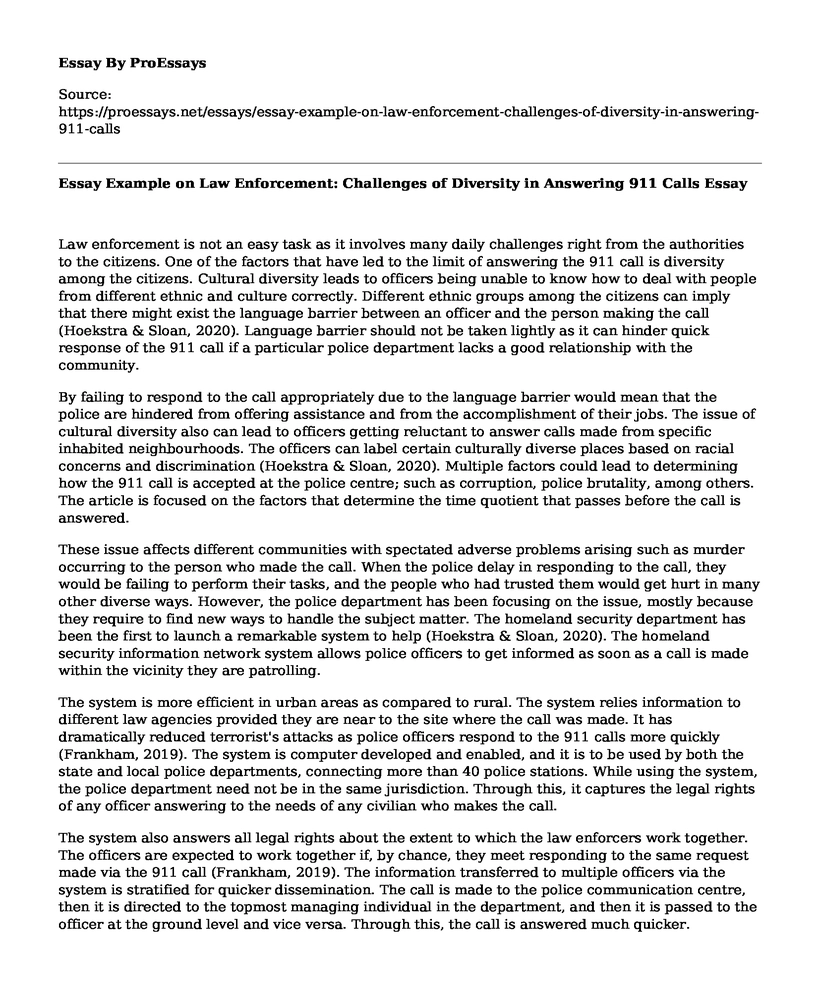Law enforcement is not an easy task as it involves many daily challenges right from the authorities to the citizens. One of the factors that have led to the limit of answering the 911 call is diversity among the citizens. Cultural diversity leads to officers being unable to know how to deal with people from different ethnic and culture correctly. Different ethnic groups among the citizens can imply that there might exist the language barrier between an officer and the person making the call (Hoekstra & Sloan, 2020). Language barrier should not be taken lightly as it can hinder quick response of the 911 call if a particular police department lacks a good relationship with the community.
By failing to respond to the call appropriately due to the language barrier would mean that the police are hindered from offering assistance and from the accomplishment of their jobs. The issue of cultural diversity also can lead to officers getting reluctant to answer calls made from specific inhabited neighbourhoods. The officers can label certain culturally diverse places based on racial concerns and discrimination (Hoekstra & Sloan, 2020). Multiple factors could lead to determining how the 911 call is accepted at the police centre; such as corruption, police brutality, among others. The article is focused on the factors that determine the time quotient that passes before the call is answered.
These issue affects different communities with spectated adverse problems arising such as murder occurring to the person who made the call. When the police delay in responding to the call, they would be failing to perform their tasks, and the people who had trusted them would get hurt in many other diverse ways. However, the police department has been focusing on the issue, mostly because they require to find new ways to handle the subject matter. The homeland security department has been the first to launch a remarkable system to help (Hoekstra & Sloan, 2020). The homeland security information network system allows police officers to get informed as soon as a call is made within the vicinity they are patrolling.
The system is more efficient in urban areas as compared to rural. The system relies information to different law agencies provided they are near to the site where the call was made. It has dramatically reduced terrorist's attacks as police officers respond to the 911 calls more quickly (Frankham, 2019). The system is computer developed and enabled, and it is to be used by both the state and local police departments, connecting more than 40 police stations. While using the system, the police department need not be in the same jurisdiction. Through this, it captures the legal rights of any officer answering to the needs of any civilian who makes the call.
The system also answers all legal rights about the extent to which the law enforcers work together. The officers are expected to work together if, by chance, they meet responding to the same request made via the 911 call (Frankham, 2019). The information transferred to multiple officers via the system is stratified for quicker dissemination. The call is made to the police communication centre, then it is directed to the topmost managing individual in the department, and then it is passed to the officer at the ground level and vice versa. Through this, the call is answered much quicker.
The policing problem can be solved via the creation of liaisons. Police officers should be incorporated from various departments; the local, state and federal departments. This would help to explain and fasten inter-agency issues based on answering the calls. It would be a collaboration, and it would enable the officers to work together, not only to solving the requests made by citizens, but also making sure they are safe. Creating liaisons can also lead to other factors being eliminated (Frankham, 2019). An example is that it can assist in the reduction of corruption rates among police officers. While working together, a dirty police officer would feel shy to accept bribes that were intended to make them fail to answer the 911 calls.
References
Hoekstra, M., & Sloan, C. (2020). undefined. https://doi.org/10.3386/w26774
Frankham, E. (2019). Mental health crisis 911 calls, resources, and inequality. https://doi.org/10.31235/osf.io/dxqhp
Cite this page
Essay Example on Law Enforcement: Challenges of Diversity in Answering 911 Calls. (2023, May 17). Retrieved from https://proessays.net/essays/essay-example-on-law-enforcement-challenges-of-diversity-in-answering-911-calls
If you are the original author of this essay and no longer wish to have it published on the ProEssays website, please click below to request its removal:
- Responses to Qestions on Euthanasia
- Essay Sample on Draft Analysis
- Definition Essay on Family
- Essay Sample on Pre-Charge Diversion Programs in New Brunswick: A Community-Level Model for Justice
- Essay Sample on Eisenhower's Address: Mixed Feelings About Brown v. Board
- Essay Example on Jury in the Courtroom: Ensuring Impartial Justice and Reasonableness
- The Greatest Lufthansa Robbery - Essay Sample







